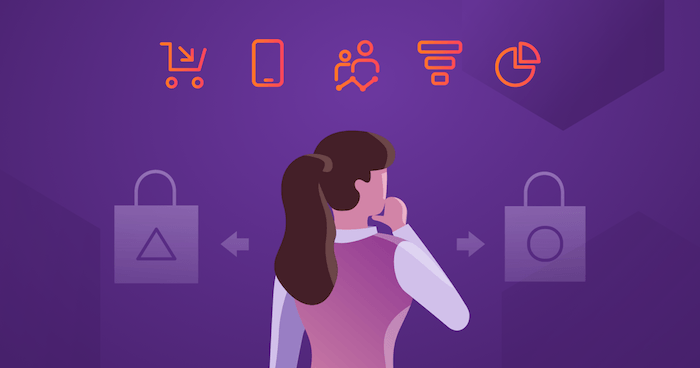If you make money online, your website or app is your bread and butter. It’s one of the primary ways customers interact with your brand, and the experiences that they have in your app or on your site can
make or break their decision to return to you or spend money with you at all in the first place.
This probably isn’t news for you. You’re likely running A/B tests or incorporating customer feedback to improve your site all the time. But the most effective way to deliver the best customer experience is by having the right data. The right data in this case is data about how your customers behave on your site at an individual level. So what are some high impact interactions and behaviors that you should be tracking? Well, it comes down to the questions you need to answer as a business, but here are five types of customer interactions that can make a difference for your bottom line:
Five important interactions you should capture
Calls to Action
One of the first things you’re going to want to think about tracking on your website or app is the way your customers interact with your calls to action (CTA). These have an obvious correlation to revenue and the success of your site, since they represent the actions that you want your customers to take. If you’ve set them up well, increasing the conversion rate on your CTAs should increase your revenue and the lifetime value of your customers. If you don’t understand how your CTAs are performing, you’re missing out on a lot of potential insight and lacking the basis to figure out how to make your customer experience better.
For your CTAs, you’ll want to make sure you’re capturing the full picture of what you want your customers to do. For example, if you have a modal popup on your blog that prompts visitors to subscribe, as well as a separate “subscribe here” sidebar, you’ll want to make sure you’re capturing how your customers interact with both of those CTAs.
Tracking your CTAs can help you answer questions like:
- Which of my CTAs are performing the best?
- Are my content CTAs converting better than my free sample CTAs?
Cross-platform visits
In today’s world, people visit your site from multiple devices. For example, a common flow is for someone to find your site on their work computer, check it out again on their phone on the way home, and visit from their tablet at home to make a purchase. Being able to recognize that all three of those visits are the same person makes a huge difference for understanding your business and your customers’ journeys.
A real-life example: we’ve seen e-commerce companies that specialize in expensive items like mattresses learn that the majority of their mobile traffic doesn’t convert to purchases, but instead comes back on their computers to make the real purchase. Since they realized that their mobile visitors ultimately became web customers, they’ve built out extensive content portals specifically for mobile to help them make the decision to purchase later on their computers.
Tracking cross-platform visits can help you answer questions like:
- Which of my users are using my site across multiple platforms?
- For users that access my site across multiple platforms, which platform converts best?
- Which platforms are my customers using for research and which are they using for purchases?
Repeat purchases and lifetime value
Being able to understand repeat visits, purchases, and how valuable each customer is to your business is a must-have. It’s not enough to just keep track of
customer touchpoints like the first conversion event; you need to understand customer journeys. Optimizing your customer journey to bring in first time buyers is important, but for many types of businesses, repeat purchasers drive a substantial chunk of revenue. By gathering a complete view of customer identity, you can understand how repeat purchasers interact with your site and how you can improve their experiences and convert them at a higher rate.
Tracking your repeat purchases and customer lifetime value can help you answer questions like:
- What kind of users have the highest LTV for me?
- How many users make repeat purchases?
- What kind of flow do returning purchasers go through to find their next purchase?
Specific customer segment experiences
Your customers are not one homogenous group. Customers from specific geographies, age groups, company sizes, and more may have different impressions of your site or app. Being able to segment your customers along strategic and relevant lines for your business to understand how they’re interacting with your site can unlock surprising insights.
One real-life example: we knew an e-commerce company that had a wide international presence, and discovered that their customers in certain cities were behaving very differently than their average customer. When they dug a bit deeper, they learned that those cities all had extremely bad traffic, and people were browsing their site in sporadic gaps during standstills in their commutes! This led them to create specific experiences for those types of customers to help them better engage and win more business in those cities.
Tracking specific customer segment experiences can help you answer questions like:
- Are my customers in California interacting with my landing pages differently than my customers in New York?
- Are customers from large companies reading my blog posts, or is it more individuals from small companies?
Funnels
Many sites have funnels that they want their customers to go through. These funnels will take them through stages from awareness to education to evaluation to purchase. Understanding your funnels will tell you where the most customers are dropping out, or if certain steps are working extremely well for you.
Tracking funnel performance can help you answer questions like:
- What percentage of customers come from my ads to my blog to contact sales?
- Do more customers make purchases after they look at similar products or from going direct to the final product page?
Conclusion
Your customers are your lifeblood. If you don’t understand what real individual people are doing on your site and the experiences that they have, then you’re inevitably leaving money on the table. Aggregate views of all visitors or shallow level understandings of one or two things about user properties won’t cut it.
In today’s world, loyalty is driven by customer experience much more so than the actual product. If you don’t understand your customers, how can you offer them the best experience?
Now, the fact of the matter is that we don’t always know exactly what’s important to driving revenue and improved customer experience ahead of time, so building a culture of asking the right questions is more important than trying to create a perfect tracking plan. Solutions that automatically capture all your customer behavior data for you enable you to ask the right questions and get answers fast, rather than having to instrument new things to track and waiting weeks for data.
Josh Dreyfuss is a Content Marketing Manager at Heap. When not helping Heap deliver a world-class customer behavioral data tool, he enjoys backpacking, poetry, and beer. He holds an MBA from INSEAD and currently lives in San Francisco, CA. 




